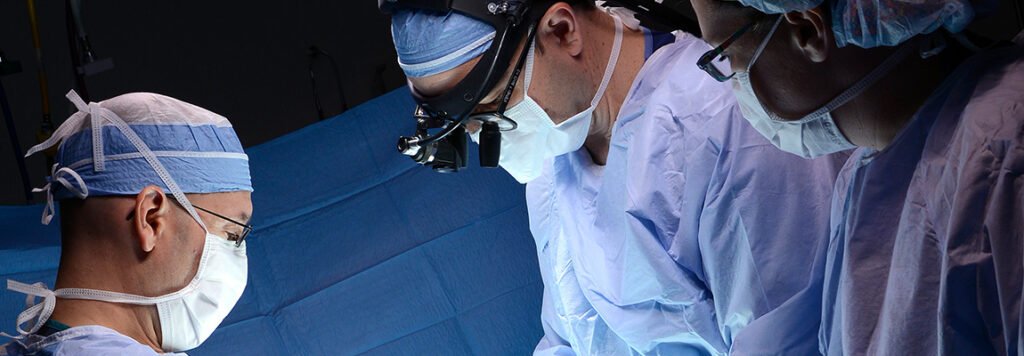Lumbar Spine Surgery

The Lumbar Spine is also known as Lower Back. A Lumbar Spine Surgery is performed in the Lower back region. Lower Back Pain is the most common type of pain in older people. The Lumbar Spine is made up of five to six vertebrae depending on the individual. The vertebrae in the lumbar spine area are the largest of the entire spine. Lower back or Lumbar Spine has to perform more functions than the thoracic spine as well as carries all upper body weight hence it is more commonly affected by degenerative disc disease or injuries. In Lumbar Spine, the lower spine curves slightly in inward direction towards the abdomen. There are many structures in the lumbar spine which can cause pain. Many lumbar spine conditions are interrelated with each other.
Spine Surgeon performs Lumbar Spine Surgery if patient is suffering from severe lower back pain and if all non surgical treatments failed to relive lower back pain. Today most of the lumbar spine surgeries are performed by minimally invasive technique instead of traditional open surgery technique.
Common causes of Lumbar Spine Pain
Muscular Problems
The most common cause of Lumbar Spine pain is the muscle strain or other muscle problems. Muscle straining occurs due to heavy lifting, bending, strenuous activities but muscle strains usually heal within a few days or weeks.
Degenerated Discs
Intervertebral discs are spongy pads acting as shock absorbers between each of the lumbar spine’s vertebrae. Disc degeneration can cause extreme pain in the disc space. Discs degeneration is most commonly found in older age people.
Lumbar Spine Disc Herniation
Herniated discs are most common in the lumbar spine. A Herniated disc can occur suddenly due to the injury or heavy lifting. Herniated disc can also occur slowly as a part of the general wear and tear on the spine.



Sacroiliac Joint Dysfunction
The sacroiliac joint connects with the bottom of the lumbar spine and the top of the tailbone. It can cause lower back pain or sciatica pain if there is any type of dysfunction in the joint which allows too much movement or restricts normal movement.
Osteoarthritis
Osteoarthritis in the lumbar spine is sometimes called as facet joint arthritis. The wearing down of the protective tissue at the ends of bones (cartilage) occurs slowly and worsens over time. Osteoarthritis is mainly found in older age people. Excess friction can also produce bone spurs and joint swelling that cause tenderness, pressure to the nerve and limited range of motion.
Lumbar Spinal Stenosis
Lumbar Spinal Stenosis is a lower back condition which occurs due to the narrowing of spinal canal or one or more of the vertebral foramina. It is typically caused by degenerative arthritis. Lumbar Spinal Stenosis can cause lower back pain as well as pain, weakness and numbness in the legs.



Types of Lumbar Spine Surgery
Lumbar Discetomy
Lumbar Discectomy is a minimally invasive surgery used to remove a herniated or degenerative disc in the lower spine. In this surgery, the incision is made posterior through the back muscles to remove the disc pressing on the nerve. Discectomy is performed if physical therapy or medication fails to relieve back pain or if patient has signs of nerve damage such as weakness or loss of feeling in legs.


Lumbar Laminectomy
Laminectomy surgery enlarges spinal canal to relieve pressure on the spinal cord or nerves. A laminectomy involves removing the lamina. Laminectomy is generally performed when the medication, physical therapy or injections failed to relieve symptoms. Laminectomy is also recommended if symptoms are severe or worsening over the time.
Lumbar Spinal Fusion
Lumbar Spinal Fusion surgery is basically removes the soft tissues between two or more adjacent vertebral bones and replaces them with bone or metal. In Lumbar Spine Fusion surgery, two or more vertebrae are fused together for form a single immobile unit. In the lumbar spine, fusion is done from the back (posterior approach), the front (anterior approach), and the side (lateral approach) or combined. Lumbar Spine Fusion surgery is primarily used for the treatment of lower back pain caused by sacroiliac joint dysfunction. Main goals of lumbar spine fusion surgery is to stop motion between the vertebra, to reduce pain caused by movement, to stabilize a spine, to treat vertebra injury and to stop the progression of a spinal deformity such as scoliosis.


Foraminotomy
Foraminotomy surgery is used to relieve pain associated with a compressed nerve in the spine. In this surgery, the surgeon cuts away bone at the sides of vertebrae to widen the space where nerves exit the spine. The extra room can relieve pressure on the nerves and reduces the pain.
Vertebroplasty and Kyphoplasty
Vertebroplasty and kyphoplasty are procedures used to treat painful vertebral compression fractures in the spinal column. In Vertebroplasty and Kyphoplasty procedure, surgeon uses imaging guidance to inject a cement mixture into the fractured bone while Kyphoplasty procedure involves one more step of insert a balloon into the fractured bone to create a space and then fill it with cement.

